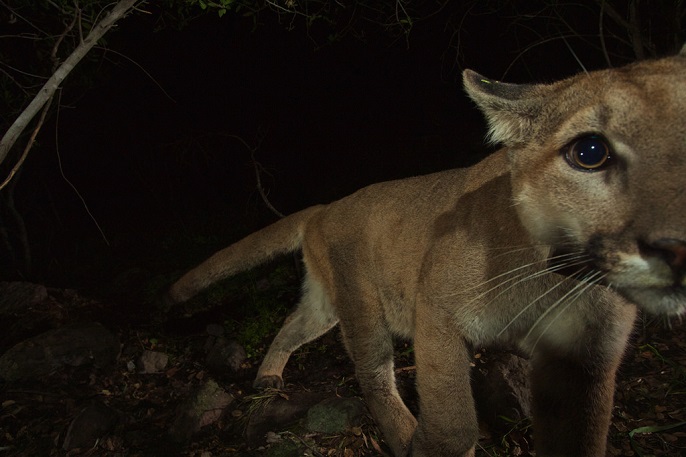|
You are viewing ARCHIVED content published online before January 20, 2025.
Please note that this content is NOT UPDATED, and links may not work. For current information,
visit https://www.nps.gov/aboutus/news/index.htm.

National Park Service
Contact: Kate Kuykendall, 805-370-2343 THOUSAND OAKS, Calif. − Following the example set by his sister, a young male mountain lion known as P-32 recently became the second big cat in less than a month to cross the 101 Freeway and disperse north, out of the Santa Monica Mountains. Prior to the recent crossings, researchers with the National Park Service had only documented one successful crossing of the 101 Freeway during the previous 13 years of the study, when P-12 crossed from north to south in early 2009. P-32 is the first male in the study to successfully disperse out of the Santa Monica Mountains. “Almost all of the young male mountain lions we’ve studied die prematurely, either from a vehicle collision or after a fight with a dominant adult male,” said Dr. Seth Riley, a wildlife ecologist for Santa Monica Mountains National Recreation Area. “It’s hugely significant that P-32 was able to disperse out of the Santa Monica Mountains so that he has a chance to avoid larger males and eventually establish his own territory.” P-32 crossed the 101 Freeway early on the morning of April 3, less than a month after his sister, P-33, ventured across. Both animals crossed on the far western end of the Santa Monica Mountains, near the border of Thousand Oaks and Camarillo. Although the exact path is unclear, GPS data indicate P-32 crossed the freeway about one mile east of P-33. Biologists believe both animals dashed across the actual roadway, rather than through a culvert or other underpass. As is the case all along the 101 Freeway along the Santa Monica Mountains, there are very few suitable and safe crossing locations for wildlife in this area. Unlike his sister, P-32 then navigated his way across State Route 23, near the Ronald Reagan Presidential Library, and into the core natural area of the Simi Hills. P-33, on the other hand, traveled right up to State Route 23 and turned around, returning back to near where she originally crossed the 101 Freeway. The National Park Service originally marked P-32 and P-33, along with a female sibling known as P-34, when they were four weeks old. Now approximately 17 months old, these two were featured in a series of stunning photographs shortly before they dispersed from their mother. Providing connections between the big cats of the Santa Monica Mountains and the populations in the Simi Hills, Santa Susana Mountains and beyond is critical for maintaining the long-term genetic health of the population. The Liberty Canyon area remains the most ideal location for a proposed wildlife crossing across the 101 Freeway because the habitat connection to the north is the strongest. There is also an existing underpass for wildlife under Highway 118 north of Liberty Canyon, with contiguous protected open space in between. P-22 is believed to have crossed the 101 and 405 Freeways as he headed east, but he was not wearing a tracking device at the time. Though he found his own territory away from dominant males, his dispersal is not considered successful because he remains hemmed in by multiple freeways and has no opportunities for reproduction. Since 2002, the National Park Service has been studying mountain lions in and around the Santa Monica Mountains to determine how they survive in an increasingly fragmented and urbanized environment. Santa Monica Mountains National Recreation Area (SMMNRA) is the largest urban national park in the country, encompassing more than 150,000 acres of mountains and coastline in Ventura and Los Angeles counties. A unit of the National Park Service, it comprises a seamless network of local, state and federal parks interwoven with private lands and communities. As one of only five Mediterranean ecosystems in the world, SMMNRA preserves the rich biological diversity of more than 450 animal species and 26 distinct plant communities. For more information, visit www.nps.gov/samo. ### |
Last updated: November 1, 2018
